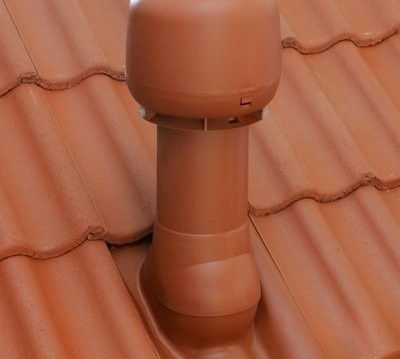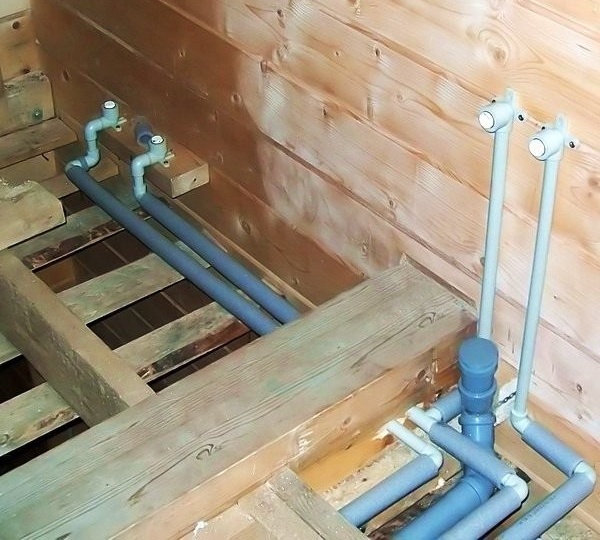Sewerage in a private house: what to put - a cesspool, septic tank or treatment station?
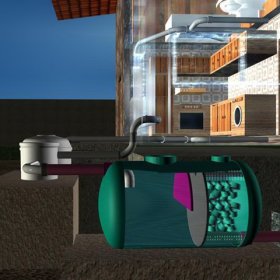
Today, a well-maintained country house is not an exception, but rather a confirmation of the rule. At the same time, the arrangement of the drainage system is perhaps the most difficult task. Sewerage device in a country house can be produced in different ways, differing in efficiency, practicality and, of course, cost. Which one to choose is up to the landlord. Consider the main options for arranging an autonomous sewage system, the only possible system in the absence of a centralized sewage system.
There are many different drainage technologies. They are united by the main principle: as a result of their use, the damage to the environment should be minimal, and ideally absent altogether. The main options for autonomous sewage are:
- cesspools;
- septic tanks of various types;
- deep bio-treatment stations.
Designs and principles of operation of the systems vary significantly, but they all obey the requirements of the current SanPin.
Content
Option # 1 - cesspools
The simplest device, which is a pit drive for household waste, can often be found in country houses. Its main advantage is the extreme simplicity of the arrangement.
There are two varieties of the system:
- A pit with sealed walls and a filter layer at the bottom. The drains enter, partially cleaned, passing through the filter, and go into the deep layers of the soil. The device occasionally requires cleaning in the form of pumping out accumulated sludge. The main disadvantage is the low bandwidth. If the amount of wastewater exceeds 1 cubic meter per day, such a system cannot be used.
- Sealed cesspool. The construction is a storage tank, which is periodically cleaned with a sewage machine. Such a sewer in a country house can be equipped independently: the drive is made of concrete, brick, cinder blocks, eurocubes, metal barrels and even tires. The capacity of industrial production can be used, which are produced in different volumes and shapes. It requires frequent cleaning, for which certain money is spent.
The disadvantages of cesspools of both types are:
- High risk of soil contamination and drinking water sources.
- Bad smells in the area and near the cesspool.
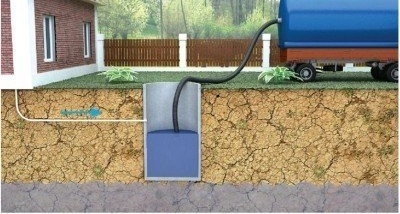
The main disadvantage of cesspools and storage tanks of any type is the need for regular pumping of accumulated domestic wastewater, which requires some expenses for paying for the services of a sewage machine
To minimize the disadvantages, the placement of structures on the site is subject to certain requirements. There should be at least 10 m from the central water supply to the cesspool, and at least 20 m from the well with drinking water.Houses and structures, both on their own and on the neighboring territory, should be located at least 12 m from the pit, otherwise the foundation may be destroyed or flooded. The distance from the fence is at least 1 m. The depth of the structure depends on the groundwater level and cannot be more than 3 m.
Option # 2 - arrangement of a septic tank
Septic tank - a device for collecting and subsequent purification of domestic wastewater. The functioning is based on the principles of gravity sedimentation and bio-purification carried out using bioenzyme preparations or forced, as well as natural methods of soil post-treatment. Depending on the amount of wastewater processed, the devices are divided into:
- single chamber - up to 1 cubic meter per day;
- two-chamber - up to 10 cubic meters meters per day;
- three-chamber - more than 10 cubic meters. meters per day.
The principle of the system simple enough: the effluent enters the receiving chamber, where large particles of impurities settle in the form of sludge. Next, the liquid enters the anaerobic fermentation chamber, where the process of wastewater purification takes place with the help of bacteria. Then, the effluents enter the next zone, where the pollution passes from the state of suspension to sediment and settles to the bottom. From here, the liquid flows to the so-called drainage fields or to filter wells for additional treatment. If this is not possible, special filters with activated materials or special UV disinfection lamps can be used.
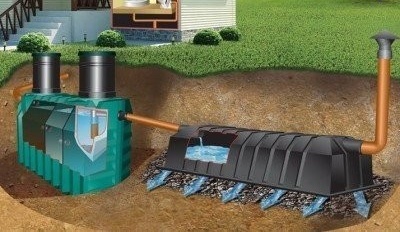
The main problem of septic tanks is insufficient wastewater treatment, therefore, the arrangement of additional after-treatment systems is required. It can be filtration fields, filter wells, etc.
In a private house, there are two ways to equip such a sewage system: purchase a finished device in a store or make it yourself. As a material for a homemade septic tank, you can choose tires, concrete, cinder blocks, brick, etc. If the construction is done correctly, it will work efficiently. The main disadvantages of septic tanks:
- A low degree of wastewater treatment, as a result of this, additional post-treatment is required.
- The need for regular pumping of sludge from the device, and the procedure is much less common than when operating cesspools. Drainage fields also need to be cleaned every 5-8 years. The soil is removed, disposed of, the pipes are cleaned and filled up with clean soil.
- In the cold season, the system may freeze.
But what the experts say:
Option # 3 - deep bio-treatment systems
Installation of an autonomous sewage system in a suburban private house may involve the use of an autonomous biological treatment complex, which is a more effective solution to the problem of wastewater. The device is a multi-chamber tank, which is equipped with special aeration devices. They saturate wastewater with air, allowing bacteria that consume oxygen to multiply. Such microorganisms are much more effective than anaerobic process organic impurities. The process taking place in wastewater treatment plants is similar to those that occur in nature. It is only slightly accelerated.
As a result of the use of bio-treatment complexes, the effluents are completely purified and separated into process water and activated sludge, which can be used several times. Waste sludge is used as an excellent fertilizer. On sale you can find many models of treatment plants, having some differences in operating principles and small design differences. When choosing a device for your site, you need to focus on the conditions in which the system will be operated.
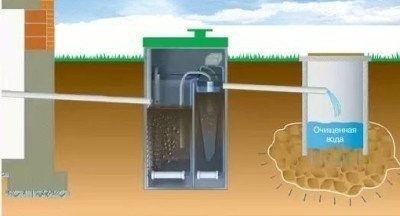
Deep bio-treatment systems separate domestic wastewater into activated sludge and industrial water purified by 98%. This is the most efficient and environmentally friendly way to clean.
The indisputable advantages of bio-purification complexes can be considered:
- High cleaning efficiency, reaching up to 98%. Whereas septic tanks yield only 30%.
- Easy to install and maintain.
- No need to install additional cleaning systems.
- Unpleasant odors are completely absent.
Among the disadvantages are the high cost of such plants, volatility, the presence of a limit for a one-time discharge of wastewater and the need for periodic replacement of compressors. In addition, the bioremediation station must operate without interruption, otherwise the colony aerobic bacteria die and have to start a new cycle. Most environmental experts believe that the installation of a deep biological treatment complex can be considered the safest and most effective way to equip an autonomous sewage system.
The lack of a centralized drainage system is not a reason to refuse to improve your home. An autonomous sewer of a country house can be organized with one's own hands, the simplest types of such systems, such as cesspools and home-made septic tanks, are traditionally equipped. Devices can provide a low level of wastewater treatment and are quite troublesome to maintain. The most effective systems are deep bio-treatment, separating wastewater into almost pure water and sludge. The relatively high cost of such structures is a deterrent to their distribution. Only the owner of suburban real estate can decide which system suits him and, given all the conditions, make the right choice.
